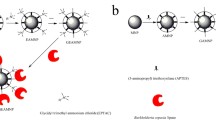Abstract
Multi-enzymatic assemblies offer the opportunity of bringing in proximity several enzymes that are enabled to work together for the catalysis of multi-step reactions. Especially, the development of robust nanobiocatalytic systems comprising of several enzymes has gained considerable attention over the last few years for the catalysis of complex reactions and the production of high added-value products. In the present chapter, we describe the methodology for the development of a bi-enzymatic nanobiocatalyst consisting of the enzymes β-glucosidase from Thermotoga maritima and lipase A from Candida antarctica (CalA) co-immobilized on chitosan-coated magnetic nanoparticles. This nanobiocatalyst can be efficiently applied for the biotransformation of oleuropein to hydroxytyrosol, a reaction of increased biotechnological interest. Several techniques, as well as methodologies that are required for the characterization of the structure and the activity of such systems are also comprehensively described.
Access this chapter
Tax calculation will be finalised at checkout
Purchases are for personal use only
Similar content being viewed by others
References
Robinson PK (2015) Enzymes: principles and biotechnological applications. Essays Biochem 59:1–41
Mohamad NR, Marzuki NH, Buang NA et al (2015) An overview of technologies for immobilization of enzymes and surface analysis techniques for immobilized enzymes. Biotechnol Biotechnol Equip 29:205–220
Zdarta J, Meyer AS, Jesionowski T et al (2018) A general overview of support materials for enzyme immobilization: characteristics, properties, practical utility. Catalysts 8:92
Nguyen HH, Kim M (2017) An overview of techniques in enzyme immobilization. Appl Sci Converg Technol 26:157–163
Zucca P, Sanjust E (2014) Inorganic materials as supports for covalent enzyme immobilization: methods and mechanisms. Molecules 19:14139–14194
Wang JΗ, Tang MΖ, Yu XΤ et al (2019) Site-specific, covalent immobilization of an engineered enterokinase onto magnetic nanoparticles through transglutaminase-catalyzed bioconjugation. Colloids Surf B Biointerfaces 177:506–511
Giannakopoulou A, Gkantzou E, Polydera Α et al (2019) Multienzymatic nanoassemblies: recent progress and applications. Trends Biotechnol 38:202–216
Garcia-Galan C, Berenguer-Murcia Á, Fernandez-Lafuente R et al (2011) Potential of different enzyme immobilization strategies to improve enzyme performance. Adv Synth Catal 353:2885–2904
Zhang G, Quin MB, Schmidt-Dannert C (2018) Self-assembling protein scaffold system for easy in vitro coimmobilization of biocatalytic cascade enzymes. ACS Catal 8:5611–5620
Wang SZ, Zhang YH, Ren H et al (2017) Strategies and perspectives of assembling multi-enzyme systems. Crit Rev Biotechnol 37:1024–1037
Gupta MN, Kaloti M, Kapoor M et al (2011) Nanomaterials as matrices for enzyme immobilization. Artif Cells Blood Substit Immobil Biotechnol 39:98–109
Rostro-Alanis MDJ, Mancera-Andrade EI, Patiño MBG et al (2016) Nanobiocatalysis: Nanostructured materials – a minireview. Biocatalysis 2:1–24
Bilal M, Zhao Y, Rasheed T et al (2018) Magnetic nanoparticles as versatile carriers for enzymes immobilization: a review. Int J Biol Macromol. 120(Pt B):2530–2544
Akın D, Yakar A, Gündüz U (2015) Synthesis of magnetic Fe3O4-chitosan nanoparticles by ionic gelation and their dye removal ability. Water Environ Res 87:425–436
Nguyen TV, Nguyen TTH, Wang SL et al (2017) Preparation of chitosan nanoparticles by TPP ionic gelation combined with spray drying, and the antibacterial activity of chitosan nanoparticles and a chitosan nanoparticle – amoxicillin complex. Res Chem Intermed 43:3527–3537
Hoang DQ, Tran TV, Tran NQ et al (2016) Functionalization of Fe3O4 nanoparticles with biodegradable chitosan-grafted-mPEG for paclitaxel delivery. Green Process Synth 5:459–466
Liu M, Yong Q, Yu S (2018) Efficient bioconversion of oleuropein from olive leaf extract to antioxidant hydroxytyrosol by enzymatic hydrolysis and high-temperature degradation. Biotechnol Appl Biochem 65:680–689
Chatzikonstantinou AV, Gkantzou E, Thomou E et al (2019) Enzymatic conversion of oleuropein to hydroxytyrosol using immobilized β-glucosidase on porous carbon cuboids. Nano 9:1166
Wu Y, Wang Y, Luo G et al (2009) In situ preparation of magnetic Fe3O4-chitosan nanoparticles for lipase immobilization by cross-linking and oxidation in aqueous solution. Bioresour Technol 100:3459–3464
Giannakopoulou A, Chatzikonstantinou AV, Chalmpes N et al (2021) Development of a novel bi-enzymatic nanobiocatalyst for the efficient bioconversion of oleuropein to hydroxytyrosol. Catalysts 11:749
Orfanakis G, Patila M, Catzikonstantinou AV et al (2018) Hybrid nanomaterials of magnetic iron nanoparticles and graphene oxide as matrices for the immobilization of β-glucosidase: synthesis, characterization, and biocatalytic properties. Front Mater 5:25
Acknowledgements
This research was co-financed by the European Regional Development Fund of the European Union and Greek national funds through the Operational Program Competitiveness, Entrepreneurship and Innovation, under the call ‘Aquaculture’—‘Industrial Materials’—‘Open Innovation in Culture’ (project: AntiMicrOxiPac, project code: Τ6ΥΒΠ-00232).
Author information
Authors and Affiliations
Corresponding author
Editor information
Editors and Affiliations
Rights and permissions
Copyright information
© 2022 The Author(s), under exclusive license to Springer Science+Business Media, LLC, part of Springer Nature
About this protocol
Cite this protocol
Giannakopoulou, A., Chatzikonstantinou, A.V., Tsakni, A., Chochos, C.L., Houhoula, D., Stamatis, H. (2022). A Bi-enzymatic Immobilized Nanobiocatalyst for the Biotransformation of Oleuropein to Hydroxytyrosol. In: Stamatis, H. (eds) Multienzymatic Assemblies. Methods in Molecular Biology, vol 2487. Humana, New York, NY. https://doi.org/10.1007/978-1-0716-2269-8_17
Download citation
DOI: https://doi.org/10.1007/978-1-0716-2269-8_17
Published:
Publisher Name: Humana, New York, NY
Print ISBN: 978-1-0716-2268-1
Online ISBN: 978-1-0716-2269-8
eBook Packages: Springer Protocols




